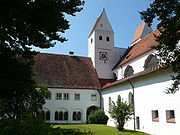
Steingaden Abbey
Encyclopedia

Premonstratensian
The Order of Canons Regular of Prémontré, also known as the Premonstratensians, the Norbertines, or in Britain and Ireland as the White Canons , are a Catholic religious order of canons regular founded at Prémontré near Laon in 1120 by Saint Norbert, who later became Archbishop of Magdeburg...
monastery in Steingaden
Steingaden
Steingaden is a town and municipality in the Weilheim-Schongau district of Upper Bavaria, Germany. It is the site of the 12th-century Steingaden Abbey and the Wies Church, a UNESCO World Heritage Site.-Geography:...
in Bavaria
Bavaria
Bavaria, formally the Free State of Bavaria is a state of Germany, located in the southeast of Germany. With an area of , it is the largest state by area, forming almost 20% of the total land area of Germany...
, Germany
Germany
Germany , officially the Federal Republic of Germany , is a federal parliamentary republic in Europe. The country consists of 16 states while the capital and largest city is Berlin. Germany covers an area of 357,021 km2 and has a largely temperate seasonal climate...
.
History

John the Baptist
John the Baptist was an itinerant preacher and a major religious figure mentioned in the Canonical gospels. He is described in the Gospel of Luke as a relative of Jesus, who led a movement of baptism at the Jordan River...
, the abbey was founded in 1147 as a Premonstratensian house by Welf VI
Welf VI
Welf VI was the margrave of Tuscany and duke of Spoleto , the third son of Henry IX, Duke of Bavaria, and a member of the illustrious Italo-German family of the Welf....
, third son of Henry the Black, Duke of Bavaria
Henry IX, Duke of Bavaria
Henry IX , called the Black, a member of the House of Welf, was duke of Bavaria from 1120 to 1126.-Life and reign:...
, and brother of Duke Henry the Proud
Henry X, Duke of Bavaria
thumb|right|Henry X in a much later engraving.Henry the Proud was the Duke of Bavaria , Duke of Saxony , and Margrave of Tuscany .-Life and reign:...
. The first monks and their abbot came from the Premonstratensian Rot an der Rot Abbey
Rot an der Rot Abbey
Rot an der Rot Abbey was a Premonstratensian monastery in Rot an der Rot in Upper Swabia, Baden-Württemberg, Germany. It was the first Premonstratensian monastery in the whole of Swabia...
. The Romanesque
Romanesque architecture
Romanesque architecture is an architectural style of Medieval Europe characterised by semi-circular arches. There is no consensus for the beginning date of the Romanesque architecture, with proposals ranging from the 6th to the 10th century. It developed in the 12th century into the Gothic style,...
abbey church was dedicated in 1176. Between 1470 and 1491 the abbey buildings were refurbished under Abbot Caspar Suiter in the Late Gothic
Gothic architecture
Gothic architecture is a style of architecture that flourished during the high and late medieval period. It evolved from Romanesque architecture and was succeeded by Renaissance architecture....
style.
The abbey was looted and burnt in 1525 during the German Peasants' War
German Peasants' War
The German Peasants' War or Great Peasants' Revolt was a widespread popular revolt in the German-speaking areas of Central Europe, 1524–1526. At its height in the spring and summer of 1525, the conflict involved an estimated 300,000 peasants: contemporary estimates put the dead at 100,000...
, and was later almost completely destroyed in the Thirty Years' War
Thirty Years' War
The Thirty Years' War was fought primarily in what is now Germany, and at various points involved most countries in Europe. It was one of the most destructive conflicts in European history....
. Reconstruction was completed in 1663 under Abbot Augustin Bonenmayr in the style of the early Baroque. During the 1740s the nave of the church was redecorated in the Rococo
Rococo
Rococo , also referred to as "Late Baroque", is an 18th-century style which developed as Baroque artists gave up their symmetry and became increasingly ornate, florid, and playful...
style.
The abbey's prestigious building projects, combined with its inaccessible location, brought it into financial difficulties which remained insuperable to the end of its existence.
Dissolution

German Mediatisation
The German Mediatisation was the series of mediatisations and secularisations that occurred in Germany between 1795 and 1814, during the latter part of the era of the French Revolution and then the Napoleonic Era....
of Bavaria. The monastic buildings were bought at auction by the Meyer brothers from Aarau
Aarau
Aarau is the capital of the northern Swiss canton of Aargau. The city is also the capital of the district of Aarau. It is German-speaking and predominantly Protestant. Aarau is situated on the Swiss plateau, in the valley of the Aar, on the river's right bank, and at the southern foot of the Jura...
, who demolished them in 1819, except for the wing containing the Romanesque cloisters.
Welfenmünster


Welf VII
Welf VII was the only son of Welf VI, Duke of Spoleto and Margrave of Tuscany, and Uta, daughter of Godfrey of Calw, count palatine of the Rhine. He was a member of the House of Welf....
, who predeceased his father in 1167. Their elaborate tomb was destroyed in 1525. The church retained however a carved sandstone panel of the Welf arms, dating from about 1200 which may well have formed part of the destroyed tomb. Apart from seal
Seal (device)
A seal can be a figure impressed in wax, clay, or some other medium, or embossed on paper, with the purpose of authenticating a document ; but the term can also mean the device for making such impressions, being essentially a mould with the mirror image of the design carved in sunken- relief or...
s and seal impressions this is the oldest known surviving heraldic representation in Germany. The panel was acquired by the Bayerisches Nationalmuseum in Munich in 1861.

